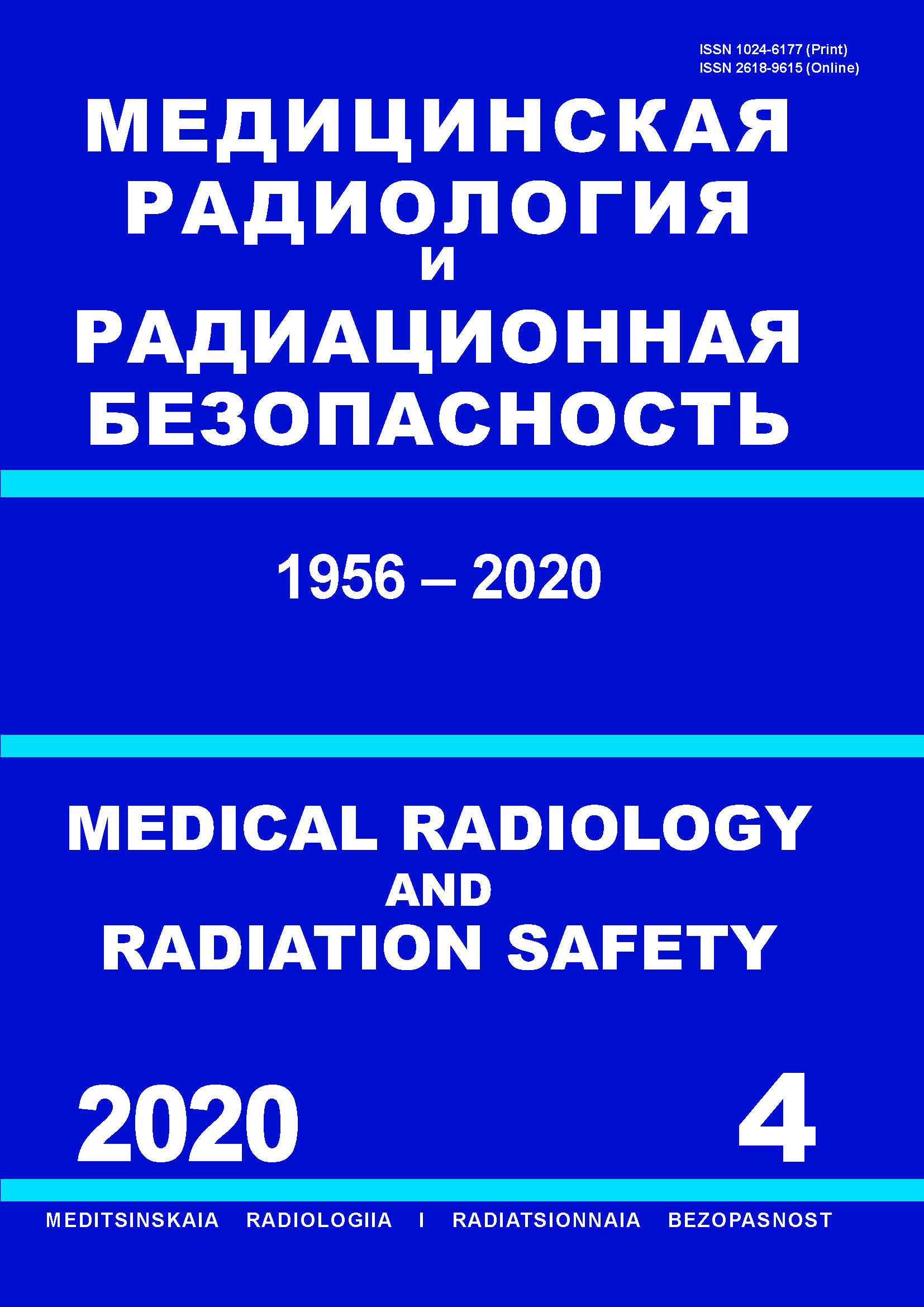VAK Russia 14.02.2004
VAK Russia 14.03.2000
UDC 61
CSCSTI 76.03
CSCSTI 76.29
Russian Classification of Professions by Education 31.06.2001
Russian Classification of Professions by Education 31.08.71
Russian Classification of Professions by Education 31.07.01
Russian Library and Bibliographic Classification 53
Russian Library and Bibliographic Classification 54
Russian Library and Bibliographic Classification 56
Russian Library and Bibliographic Classification 57
Russian Library and Bibliographic Classification 58
Russian Trade and Bibliographic Classification 5706
Russian Trade and Bibliographic Classification 5734
BISAC MED080000 Radiology, Radiotherapy & Nuclear Medicine
Purpose: The estimation of the radiation risk of leukemia incidence and mortality for occupational exposure. Material and methods: The study was conducted in the pooled cohort comprised 45,817 workers from the two enterprises; 23,443 radiation workers first employed in 1947–2002 from the Sellafield plant (Great Britain) and 22,774 workers from the Mayak PA (Russia) first employed at the main plants in 1948–1982. The period of follow-up was terminated at the end of 2008 for Mayak workers who were Ozyorsk city residents, and at the end of 2005 for Sellafield workers and Mayak workers who had migrated from Ozyorsk. Results: Comparable radiation risk estimates of leukemia incidence and mortality were found among Mayak PA and Sellafield workers as for the whole dose range and separate dose intervals. Averaged by attained age estimate of excess relative risk per 1 Gy of external gamma-dose was 3.0 (95 % CI: 1.3–6.3) under the assumption of the linear dose–effect model. The quadratic model with attained age modification showed the best quality of fit. Risk estimates were statistically significant in the dose range 0.15–1.5 Gy. There was no evidence of any relationship between leukemia risks and accumulated red bone marrow dose of internal alpha-exposure due to incorporated Pu-239. Conclusion: Preliminary analysis of the pooled cohort data has demonstrated the feasibility and efficiency of a research project looking at leukemia risks in a joint cohort of Mayak and Sellafield workers. The current study provides further evidence about the already well established link between external-gamma exposure and leukemia risk. However, it fails to provide any firm further evidence about the absence or presence of relationship between plutonium exposure and leukemia risk.
occupational exposure, radiation risk, incidence, mortality, leukemia, Russia, Great Britain, pooled cohort
1. Tsyb AF, Ivanov VK. Radiation-epidemiological studies in Russian National Chernobyl registry. News of Inst. 1994(2)3:44-53. (In Russ.).
2. Shilnikova NS, Preston DL, Ron E, et al. Cancer mortality risk among workers at the Mayak Nuclear Complex. Radiat Res. 2003;159:787-98. DOI:https://doi.org/10.1667/0033-8587(2003)159[0787:cmrawa]2.0.co;2.
3. Tahauov RM, Karpov AB, Zerenkov AG, et al. Medical-dosimetry registry of personnel at Sibirian chemical enterprise - database for estimation of effects of prolonged radiation exposure. Radiat Biology. Radioecol. 2015(5):467-73. (In Russ.)].
4. Trikman OP, Lomakin AI, Zhilkina LA, et al. Medical-dosimetry registry of personnel at mining and chemical enterprise. The estimation of radiation significance influence on leukemia morbidity and mortality among workers and population of town Zheleznogorsk. News CH № 51. 2015;5(2):24-30. (In Russ.).
5. Muirhead CR, O’Hagan JA, Haylock RG, et al. Third Analysis of the National Registry for Radiation Workers: Occupational Exposure to Ionising Radiation in Relation to Mortality and Cancer Incidence. Health Protection Agency. 2009:1-156.
6. Sokolnikov M, Preston D, Gilbert E, et al. Radiation Effects on Mortality from Solid Cancers Other than Lung, Liver, and Bone Cancer in the Mayak Worker Cohort: 1948-2008. PLoS ONE. 2015;10(2):e0117784. DOI:https://doi.org/10.1371/journal.pone.0117784.
7. Napier BA, Efimov A. Baker SC. The Mayak worker dosimetry system (MWDS2013) for external irradiation. 2018.
8. ICRP Publication 66. Human respiratory tract model for radiological protection. Ann ICRP. 1994;24(1-3).
9. ICRP Publication 30 (part 1). Limits of intakes of radionuclides by workers. Ann ICRP. 1978;2(3-4).
10. Birchall A, Vostrotin V, Puncher M, et al. SOLO Sub-project 3, Work Package 3.1 - Deliverable 3.1.5: Internal dosimetry protocol for the Proposed Mayak-Sellafield Worker Epidemiological Study, 2013.
11. Riddell AE, Birchall A, Puncher M, et al. SOLO Sub-project 3, Work Package 3.3 - Deliverable 3.3.1: report on the development and validation of plutonium dose assessment systems for epidemiological research, 2015.
12. Preston DL, Lubin JH, Pierce DA, McConney ME. Epicure, release 2.10. HiroSoft: Seattle, WA, USA, 1998.
13. Gillies M, Haylock R, Hunter N, Zhang W. Risk of Leukemia Associated with Protracted Low-Dose Radiation Exposure: Updated Results from the National Registry for Radiation Workers Study. Radiat Res. 2019;192(5):527-37. DOI:https://doi.org/10.1667/RR15358.1
14. Cardis E, Vrijheid M, Blettner M, et al. The 15-country collaborative study of cancer risk among radiation workers in the nuclear industry: estimates of radiation-related cancer risk. Radiat Res. 2007;167:396-416. DOI:https://doi.org/10.1667/RR0553.1.
15. Leuraud K, Richardson DB, Cardis E, et al. Ionising radiation and risk of death from leukaemia and lymphoma in radiation-monitored workers (INWORKS): an international cohort study. Lancet Haematol. 2015:2(7):e276-81. DOI:https://doi.org/10.1016/S2352-3026(15)00094-0.
16. Schubauer-Berigan MK, Daniels RD, Bertke SJ, et al. Cancer mortality through 2005 among a pooled cohort of U.S. nuclear workers exposed to external ionizing radiation. Radiat Res. 2015;183:620-31. DOI:https://doi.org/10.1667/RR13988.1.
17. Metz-Flamant C, Laurent O, Samson E, et al. Mortality associated with chronic external radiation exposure in the French combined cohort of nuclear workers. Occup Environ Med. 2013;70:630-8. DOI:https://doi.org/10.1136/oemed-2012-101149.





